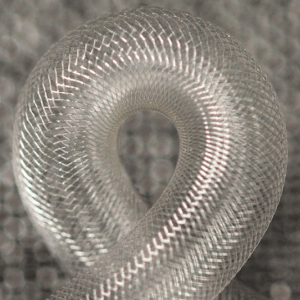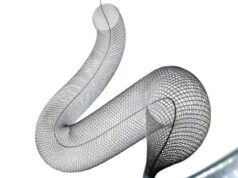The preliminary safety data of a “self-expanding primarily bioabsorbable flow-diverting” stent has shown to be consistent with a favourable profile in terms of mechanical behaviour, haemocompatibility, side branch patency, and histological effects. Intended for aneurysm use, the authors write that additional in vitro and long-term in vivo studies are in progress and will determine aneurysm occlusion rates and absorption characteristics of the stent.
 Describing their device as unique with respect to its deliverability with conventional microcatheters, and adding that it is self-expandable and does not require angioplasty after deployment, the authors, Mehdi Jamshidi and colleagues from the University of Calgary, Calgary, Canada, report that crush resistance force and haemolytic behaviour were “similar to existing commercial devices,” while thrombogenicity was “lower than metal flow-diverting stents”. At follow-up, the investigators found that all covered side branches were angiographically patent, and a smooth neointimal layer was found over the absorbable stent surface. The results were published in the Journal of Neurointerventional Surgery (JNIS).
Describing their device as unique with respect to its deliverability with conventional microcatheters, and adding that it is self-expandable and does not require angioplasty after deployment, the authors, Mehdi Jamshidi and colleagues from the University of Calgary, Calgary, Canada, report that crush resistance force and haemolytic behaviour were “similar to existing commercial devices,” while thrombogenicity was “lower than metal flow-diverting stents”. At follow-up, the investigators found that all covered side branches were angiographically patent, and a smooth neointimal layer was found over the absorbable stent surface. The results were published in the Journal of Neurointerventional Surgery (JNIS).
Although Jamshidi and team acknowledge the development and success of metal flow-diverting stents for aneurysm treatment, they write that these devices are still associated with clinically significant long-term complications such as delayed thrombosis, in-stent stenosis, and inflammatory responses, the latter of which can lead to neointimal hyperplasia.
They point to the fact that once aneurysm occlusion occurs, a metal stent cannot be removed, even when it is not required. “Their long-term presence may prevent normal arterial growth and vasomotion, limit access to side branches for future procedures, and interfere with radiographic visualisation of neighbouring structures or pathologies,” explain Jamshidi and colleagues.
The authors postulate that bioabsorbable stents can mitigate the long-term complications by “being absorbed after first achieving the short-term goals of stent placement”. They theorise that this characteristic has a multitude of advantages, including eliminating the long-term rigidity of the stented artery; improving future treatment options by the lack of residual, obstructive materials; permitting the use of non-invasive imaging techniques in the region without introducing artefact, and obviating the need for a lifetime of anti-thrombotic drugs.
The ultimate goal, according to Jamshidi et al, was to develop a stent with flow-diverting characteristics, and achieve a low porosity and high pore density. In the current study, braided stents were developed using poly-L-lactic acid (PLLA) fibres with material surface area similar to metal flow diverters. Stents were deployed in infra-renal rabbit aortas to determine angiographic side branch patency. This also allowed the investigators to study neointima formation for a one-month follow-up period.
The authors write that despite these “satisfactory results” regarding the physical and mechanical properties of the stent, as well as initial haemocompatibility studies, in vivo trials are “a critical step toward success”. In addition, they speculate that further studies will determine the absorption characteristics and the long-term effectiveness of the stent porosity for the treatment of brain aneurysms.
Speaking to NeuroNews, senior author of the study, Alim Mitha, further explains what the future holds for bioabsorbable stents and outlines what his team is currently working on. “The holy grail for aneurysm treatment, or any disease for that matter, is one that is safe, effective, and leaves little or no footprint behind. For many aneurysms, flow diversion is as close to an ideal treatment as we currently have, in that it provides scaffolding for neointima formation at the aneurysm neck while averting the need to access the fragile dome.
“Unfortunately, its main drawbacks include the thromboembolic risk as well as the consequences of leaving significant amounts of metal in the parent artery for the life of the patient. The long-term effectiveness of a flow-diverting stent, however, is less likely due to the permanence of the scaffold than it is the durability of the healed tissue that forms. We know this because once an aneurysm is angiographically excluded, it is exceedingly unlikely to recur.
“Absorbable devices, therefore, have the potential to provide at least equivalent success rates and, at the same time, can address the shortcomings of metal stents. Although the results of initial safety studies are encouraging, our current research is focused on confirming the effectiveness of flow diversion and validating the value proposition of using absorbable materials over metal.”












